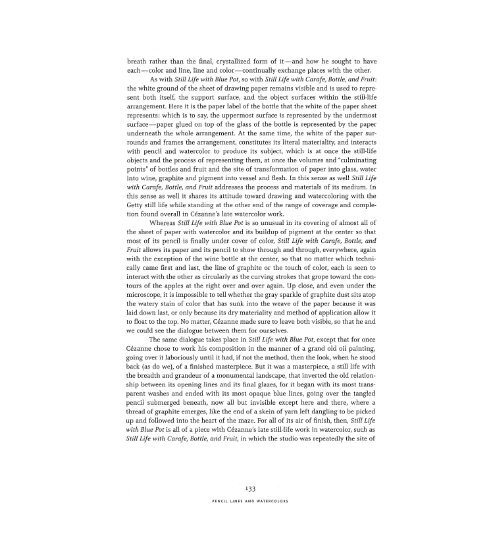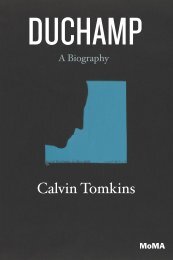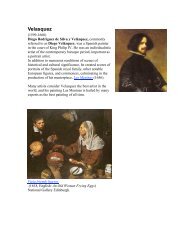Still Life in Watercolors
qbj8dgc
qbj8dgc
- No tags were found...
Create successful ePaper yourself
Turn your PDF publications into a flip-book with our unique Google optimized e-Paper software.
eath rather than the f<strong>in</strong>al, crystallized form of it—and how he sought to have<br />
each—color and l<strong>in</strong>e, l<strong>in</strong>e and color—cont<strong>in</strong>ually exchange places with the other.<br />
As with <strong>Still</strong> <strong>Life</strong> with Blue Pot, so with <strong>Still</strong> <strong>Life</strong> with Carafe/Bottle, and Fruit:<br />
the white ground of the sheet of draw<strong>in</strong>g paper rema<strong>in</strong>s visible and is used to represent<br />
both itself, the support surface, and the object surfaces with<strong>in</strong> the still-life<br />
arrangement. Here it is the paper label of the bottle that the white of the paper sheet<br />
represents: which is to say, the uppermost surface is represented by the undermost<br />
surface—paper glued on top of the glass of the bottle is represented by the paper<br />
underneath the whole arrangement. At the same time, the white of the paper surrounds<br />
and frames the arrangement, constitutes its literal materiality, and <strong>in</strong>teracts<br />
with pencil and watercolor to produce its subject, which is at once the still-life<br />
objects and the process of represent<strong>in</strong>g them, at once the volumes and "culm<strong>in</strong>at<strong>in</strong>g<br />
po<strong>in</strong>ts" of bottles and fruit and the site of transformation of paper <strong>in</strong>to glass, water<br />
<strong>in</strong>to w<strong>in</strong>e, graphite and pigment <strong>in</strong>to vessel and flesh. In this sense as well <strong>Still</strong> <strong>Life</strong><br />
with Carafe, Bottle, and Fruit addresses the process and materials of its medium. In<br />
this sense as well it shares its attitude toward draw<strong>in</strong>g and watercolor<strong>in</strong>g with the<br />
Getty still life while stand<strong>in</strong>g at the other end of the range of coverage and completion<br />
found overall <strong>in</strong> Cezanne's late watercolor work.<br />
Whereas <strong>Still</strong> <strong>Life</strong> with Blue Pot is so unusual <strong>in</strong> its cover<strong>in</strong>g of almost all of<br />
the sheet of paper with watercolor and its buildup of pigment at the center so that<br />
most of its pencil is f<strong>in</strong>ally under cover of color, <strong>Still</strong> <strong>Life</strong> with Carafe, Bottle, and<br />
Fruit allows its paper and its pencil to show through and through, everywhere, aga<strong>in</strong><br />
with the exception of the w<strong>in</strong>e bottle at the center, so that no matter which technically<br />
came first and last, the l<strong>in</strong>e of graphite or the touch of color, each is seen to<br />
<strong>in</strong>teract with the other as circularly as the curv<strong>in</strong>g strokes that grope toward the contours<br />
of the apples at the right over and over aga<strong>in</strong>. Up close, and even under the<br />
microscope, it is impossible to tell whether the gray sparkle of graphite dust sits atop<br />
the watery sta<strong>in</strong> of color that has sunk <strong>in</strong>to the weave of the paper because it was<br />
laid down last, or only because its dry materiality and method of application allow it<br />
to float to the top. No matter, Cezanne made sure to leave both visible, so that he and<br />
we could see the dialogue between them for ourselves.<br />
The same dialogue takes place <strong>in</strong> <strong>Still</strong> <strong>Life</strong> with Blue Pot, except that for once<br />
Cezanne chose to work his composition <strong>in</strong> the manner of a grand old oil pa<strong>in</strong>t<strong>in</strong>g,<br />
go<strong>in</strong>g over it laboriously until it had, if not the method, then the look, when he stood<br />
back (as do we), of a f<strong>in</strong>ished masterpiece. But it was a masterpiece, a still life with<br />
the breadth and grandeur of a monumental landscape, that <strong>in</strong>verted the old relationship<br />
between its open<strong>in</strong>g l<strong>in</strong>es and its f<strong>in</strong>al glazes, for it began with its most transparent<br />
washes and ended with its most opaque blue l<strong>in</strong>es, go<strong>in</strong>g over the tangled<br />
pencil submerged beneath, now all but <strong>in</strong>visible except here and there, where a<br />
thread of graphite emerges, like the end of a ske<strong>in</strong> of yarn left dangl<strong>in</strong>g to be picked<br />
up and followed <strong>in</strong>to the heart of the maze. For all of its air of f<strong>in</strong>ish, then, <strong>Still</strong> <strong>Life</strong><br />
with Blue Pot is all of a piece with Cezanne's late still-life work <strong>in</strong> watercolor, such as<br />
<strong>Still</strong> <strong>Life</strong> with Carafe, Bottle, and Fruit, <strong>in</strong> which the studio was repeatedly the site of<br />
133<br />
PENCIL LINES AND WATERCOLORS




